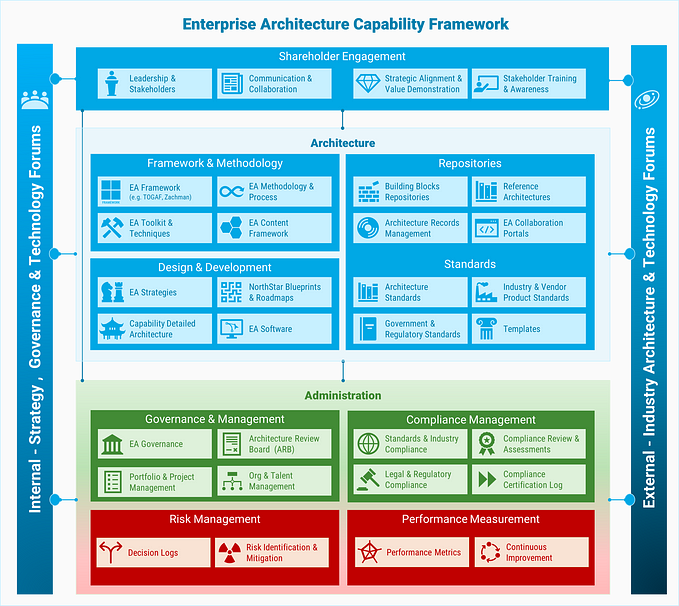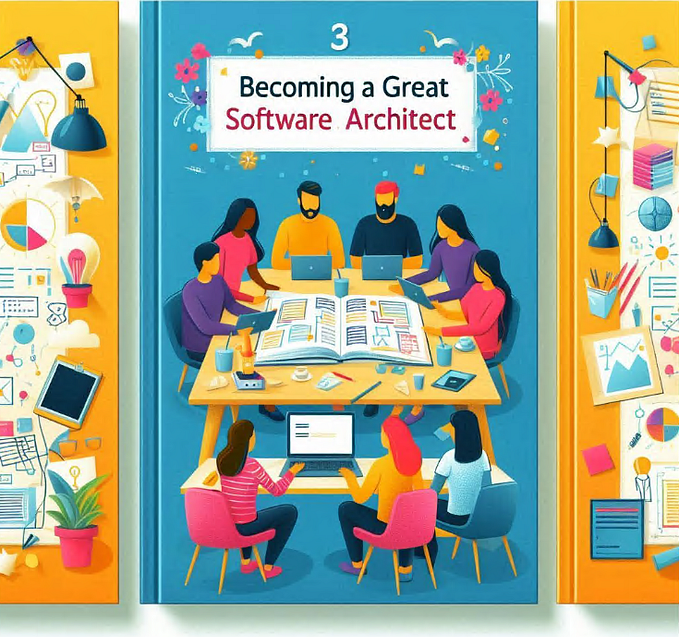12 Patterns of Platform Design to kickstart Innovation Strategies
DIY Pattern Cards that can help you frame the Platform Design opportunity available in your context

This post is brought to you by platformdesigntoolkit.com and is dispatched in our fortnightly newsletter
As the loyal readers know, we recently introduced an experimental framework (see: “Exploring Ecosystems: The Patterns of Platformization”), to help adopters of our methodology scan the market horizon, with the aim of spotting patterns of opportunity to apply a platform strategy. In this post, we followup on this research, and present a prototype of Pattern Cards.
The focus of this post will be — even more strictly — on the “exploration” phase: the moment when a platform shaper wants to understand along which lines the platform strategy can play out.
We imagine the patterns we present today to be used a bit like “cards” in a game: these “pattern cards” are designed to spark considerations that — in our experience — are essential in the opening phase, even before mapping the ecosystem.
- Methodology Tip > To understand more on how to map in the opening phase, beyond pattern cards, please refer to “Design for Ecosystems: Emergence & Attraction”]
The Four Phases of Platform Design
The work of a platform designer can be divided in four macro phases:
- Exploration: understanding the context, and the strategic meaning and applicability of a platform strategy that impacts, shapes and influences the context;
- Strategy Design: mapping entities, understanding their individual context, their potential to exchange value, and imagining the two key platform engines (the transactions engine, the learning engine), plus designing the experiences one wants to create for participants;
- Validation and Prototyping: conducting Ecosystem Discovery interviews (this could also partially happen during the design phase, and is generally an iterative process), making the MVPs or the experiments dedicated to validate or invalidate the assumptions;
- Growth Hacking: applying tactics to help the strategy grow in the context (being it a market, or something different) and achieve niche enablement and network effects;
The patterns we present today, all operate in the Exploration phase. In the next weeks we will introduce more patterns, that operate in other phases such as Growth Hacking.
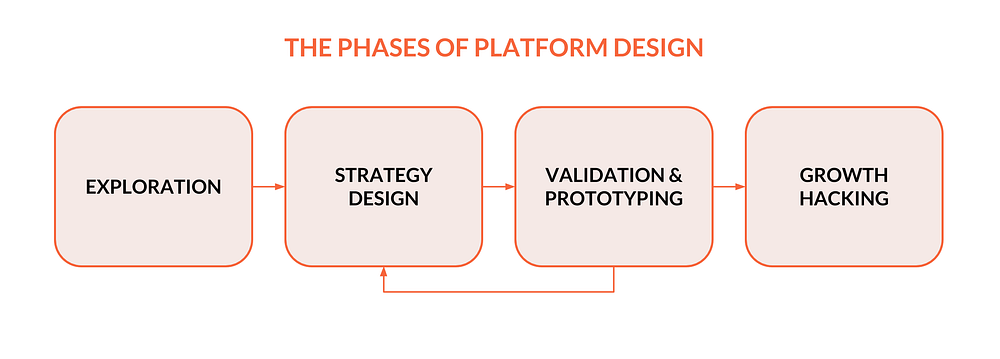
What’s a good context for Platform Design?
Beyond the idea of exploring markets to identify opportunities for platformization, partners, customers and adopters have raised all sorts lot of questions related to the applicability of Platform Design Toolkit (and Platform Design) in contexts that are increasingly varied.
Adopters generally feel that platform design is a lens they want to use to enhance and transform what they do, or care about. Often it’s about evolving their existing organizations or product and service offerings, or exploring new markets.
The Opening Question: how can I use Platform Design in my Context?
How can I apply Platform Design to improve and transform the project, product or mission I’m currently working on?
To answer this recurring question, we can roughly define two macro types of contexts of application: ecosystem mobilization and product/service innovation. Let’s see the details.
A. Ecosystem Mobilization
A common context of application of platform design is related to shaping and mobilizing ecosystems that already exist. As we often say, Platform Design is heavily rooted in the observation of the emergent: you actually can’t design a strategy for an ecosystem that doesn’t exist (where exists = trying to create and exchange value). The analogy would be designing a solution for an inexistent problem: who would like to do that?
This consideration is at the core of the first context of applicability: if you see that value is being created and traded in a market (or any other societal context that you don’t want to call like that); if you see producers and consumers that are self organizing around value creation, and you think this market is performing below potential, then this context is perfectly worth of organizing through a platform strategy that amplifies this potential. We call this context, ecosystem mobilization.
B. Product & Service Innovation
Another recurring case is that of players trying to organize a larger ecosystem of interactions that is, or could be, happening around a product or service that already exists: something that an organization provides as a consumable product or service. In this case there’s already an ecosystem of entities using the product or service as a component of a value chain that leads to higher value services: the platform shaper might want to capture value in this ecosystem. Let’s call it, product/service innovation (platformization).
A further, inherent, context: The Organization
If we look to the mentioned contexts a bit more broadly, we can quickly understand that there’s a third (shadow) context that is somehow mixed with the two. Indeed, there’s always an existing organization that:
- works as a complex network of interactions between internal and external entities (therefore being partially overlapped with the concept of ecosystem);
- produces a certain process or product (subject to the process/service innovation context).
The inextricable mix between the platformization contexts and the organizational one is a teller of something embedded in our thinking from the very start: it is ever more difficult to separate organizations from products, and organizations from ecosystems.
As we always say:
the future is going to be much more about *continuously organizing* (the verb) than *organization* (the noun).
We’re in the age of boundaryless thinking, and the boundaries between the inside and the outside of an organization — and even between a product or service, and the organization that runs it — are disappearing.
Think of Airbnb as an example: where does the organization ends and the brand, experience or ecosystem starts? Hard to tell.
What are the layers of modern digitally powered economy?
Modern contexts for interaction (call it markets if you like) are characterized by at least three layers.

Infrastructures
The layer of actionable resources. At this layer we’re seeing a lot of innovation happening, most of which can be reduced to “componentization”: making things available everywhwere, in every moment, is a leading force.
If you think that cloud computing, or blockchain infrastructures are at the forefront of this process you may be right, but we’re seeing clear signs of this happening in many other contexts.
Read this post from Simone Brunozzi to understand, for example, how this trend is reaching one of the most traditional markets –real estate– thanks to blockchain based tokenization.
In few words: everything will soon be liquid, rentable, exchangeable and tradable in one click.
Aggregators/Platforms
At an higher layer we have aggregators, platforms: networks that aggregate, connect and make these resources available. This is the layer of the dominators of today’s economy — the GAFAs.
This is the layer where the platform shaper operates, creating strategies that motivate (the narrative) to accept a shared set of rules (the primitives) and provide everyone with a context for continuous learning and improvement (the enablers).

Long Tail Markets and the job of Platform Design
Above this layers, you’ve long tail markets: this part of the market is increasingly fragmenting, with the aim of enabling more and more niche experiences.
Thriving in this layer normally means, being small, experience driven, unique.
The job of the platform shaper is essentially dual. On one hand the shaper needs to help the long tail to fragment even more, let more niches emerge, exist and thrive. As we explained recently in “Why Platform Strategies are all, about reducing Transaction Cost” reducing the transaction cost through building better channels or reducing barriers to entry by providing shared infrastructure, makes more niches appear in the long tail, and allows the market to self organize more efficiently, around smaller market opportunities (by clearly reducing the basic marginal cost of interaction).
This is the core of building a great Transaction Engine for your platform strategy: an engine that connects, makes trading value and interacting easier.
Beyond reducing transaction cost, another core pillar of Platform Design is in designing the Learning Engine: how do you support the ever increasing number of entities that you allow to play? How do you provide them a dedicated processes for continuous improvement and learning? How do you help them to move along the three staged process of Onboarding, Getting Better and Finding new opportunities to interact?
That’s what we tell to our practitioner at workshops and masterclasses: the core of your creative contribution to platformization, always keeping in mind that you design FOR the Ecosystem, is essentially:
- building channels and making choices that reduce the cost of transaction (building the transactions engine);
- creating services that support continuous learning (building the learning engine).
These two key activities represent the sweet design spot where you, first, listen and watch what the ecosystem is trying to achieve, and (later) start thinking and designing what as a platform shaper you can do to support.
If we illustrate the two main contexts of platformization in the pyramid, they could be seen as follows:
- platformization strategies that mobilize ecosystems (A) can be seen as strategies that connecting existing long tail markets, to larger sets of infrastructural resources, and aggregate them to generate network effects;
- product & Service innovation strategies (B), on the other hand, can be seen as connecting infrastructures and components (products) to larger ecosystem of users and producers, through aggregation.

Patterns for Exploration
After having shared a few essential points that should help you reconnect phases, layers and contexts of platformization, let’s proceed at releasing a new set of tools that you can play with.
First of all, here you can find an updated version of the Ecosystem Scan (v0.2) that now features — more correctly — the three layers that we recapped above: infrastructure, aggregators, long tails.
You can still refer to this post to understand the way to use it. We also updated the examples over there for your convenience, though the pattern library you find on that post will be soon superseded by the increasing releases we plan onwards.

Beyond the usage of the full approach of analysis explained in the presentation of the Ecosystem Scan, you might find useful to use this updated pattern library in a even more simple way.
How to use Pattern Cards
We suggest you to use the pattern cards as mindset challengers: we normally use them as ways to challenge the practitioners in the contextualization and mapping phases: one can just stick them on the wall, and go through them to reflect on how the patterns operate (or could) in the context under exploration. This should help understand in what main directions a platform strategy can start to operate.
All pattern cards are characterized by:
- A title;
- A brief explanation;
- A short example;
- The Layer (long tail markets, aggregators, infrastructures) where the pattern is normally operating;
- The Phase of Platform Design where the card should help more with;
Following you can find three images that link to three pdf sheets, containing four patterns each: you can just print them out and cut them into smaller cards.
Remember that the patterns we present today are all to be considered in the Exploration phase (we suggest you to use it before you actually start working on the design, as said). See the picture below for the prototype.
An Example: I want to platformize my Table Tennis Rackets business

Let’s make an over-simple example: say you’re a producer of Table Tennis Rackets and you want to platformize your business. Using the “Climb the Value Chain” pattern card (E7) you’ll be challenged to ask: what are users doing with our rackets? And you’ll probably figure out that they’re playing and getting trained on becoming a better player.
What are the entities in the higher level ecosystems then? Probably teachers, spaces where to train, tournament organizers. This reflection should then bring you to start mapping a completely new ecosystem and proceed with a platform strategy that enable (and capture) more value in the ecosystem, at a decisively higher level of services.

The Full Patterns List
Here’s the full list of clickable patterns for your convenience:



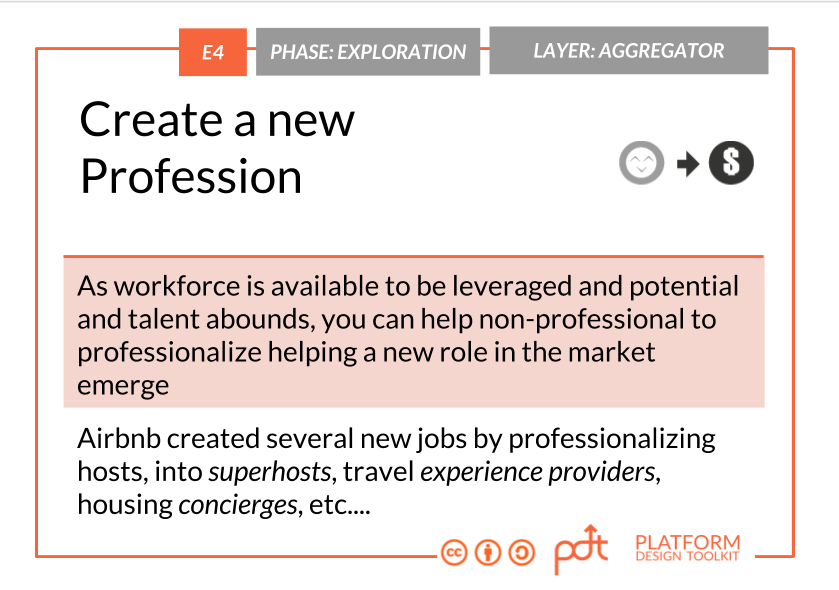





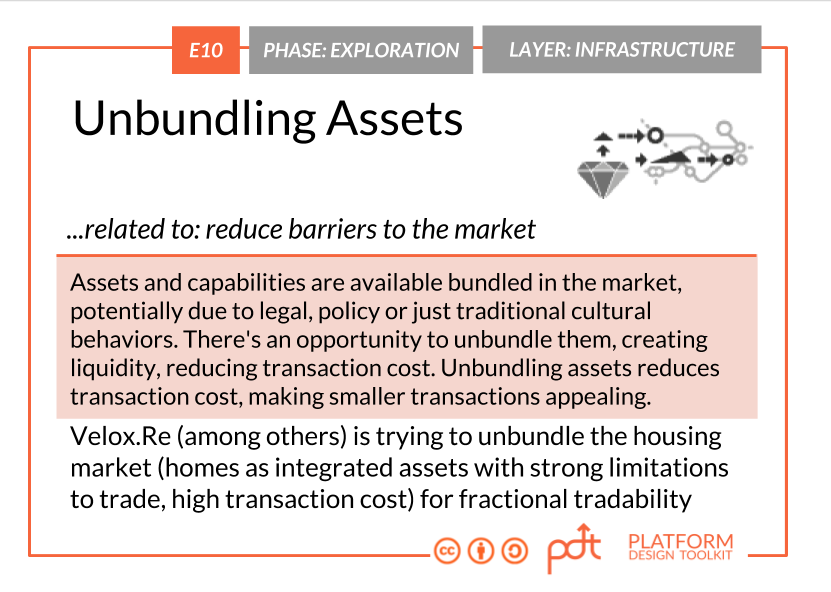



We’ve been developing these new tools to help adopters orientate and navigate the inception phase of their platformization process (exploration): these patterns will help you acquire the right mindset and get started in a meaningful way.
Stay tuned as the next 6 months are going to be very exciting in terms of new developments and releases to help our adopters self run platform design experiences. We refuse to be bottlenecks in the adoption of this new form of business thinking, and therefore we’re aiming at making it easier for everyone to challenge, design and innovate their businesses and organizations to cope with the age of networks.
Do you want to learn how to use this methodology from the ones that created and evolve it? Join our upcoming Masterclasses.
A participant once said the masterclass: “changed the perception of what is possible”.
Check all available masterclasses here on our website or reach out directly for special deals and large groups.
Before you Go!
As you may know, everything we do is released in Creative Commons for you to use. In case you’re getting value out of these reads and tools, we encourage you to click the 👏button and hold down to 20–50 claps as this will help us to get more exposure, and hopefully work more on developing these tools. Thanks for your support!
And if you’re on Twitter, give me a follow > @meedabyte
[Special Thanks to Eugenio Battaglia, Guglielmo Apolloni from the Platform Design Toolkit team, and Ron Kersic for the always great feedback]









